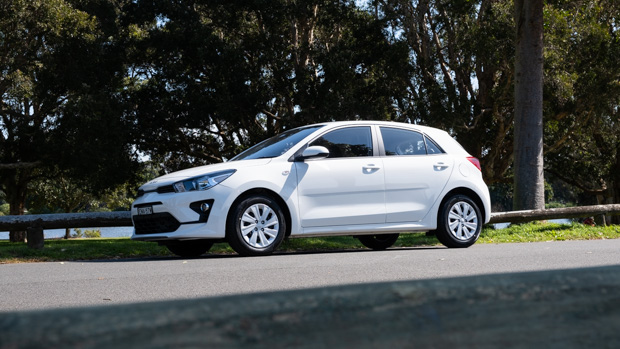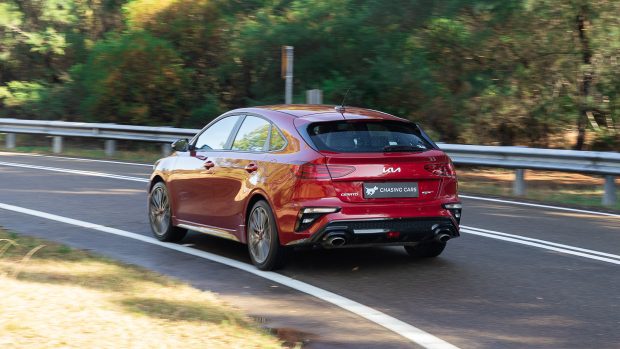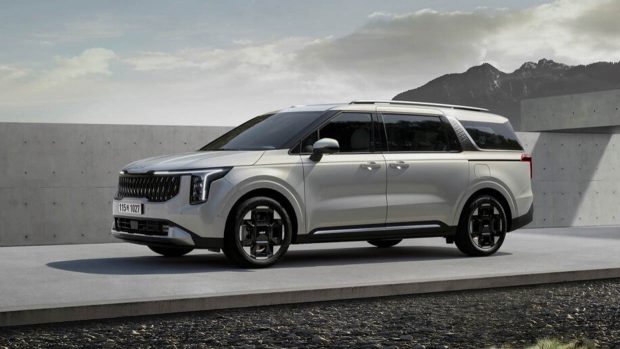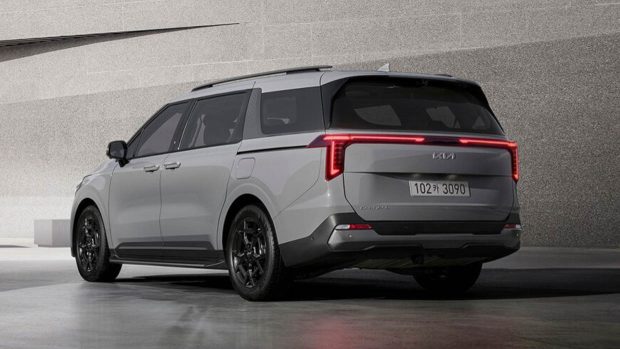-
Car Reviews
- All reviews
- Midsize SUVs
- Small cars
- Utes
- Small SUVs
- Large SUVs
- Large cars
- Sports SUVs
- Sports cars
- Vans
Latest reviews
- Car News
-
Car Comparisons
Latest comparisons
- Chasing Deals
All eyes are on Kia’s new-generation of impressive electric vehicles but it still has big plans for its petrol and diesel line-up
With Kia’s global product focus now heavily skewed towards electrification, the lifespans of its existing combustion-engined cars will be extended beyond the traditional five or six years, in a bid to ensure that Aussies aren’t left behind in the transition.
In most cases these combustion cars will be equipped with more efficient drivetrain choices – while new-generation models such as the 2025 replacement for the Cerato/Forte and the unique European-market Ceed, will merge into a single model, produced in one factory, for all global markets.
Speaking to Australian motoring media at the EV9 large SUV’s global launch, Kia’s head of global product planning Hyungsik Park said that dwindling small-car sales in major markets meant that Kia would likely no longer continue producing two completely different vehicles of the same size – one exclusively for Europe (the Ceed, built in Slovakia and Russia) and the Cerato (also badged Forte and K3 in other markets).
Kia’s new-generation small car will be unveiled later in 2024, with Australian sales set for early 2025, with this now-confirmed Cerato/Ceed replacement being built exclusively in Mexico. It will also debut Kia’s new naming convention for all its next-generation combustion-engined models, meaning a ‘K’ prefix – in this case, K4.
Given that the Mexican factory will also be installing Euro-spec engines, Kia Australia should be able to offer a range of more efficient drivetrains – particularly if the federal government’s proposed New Vehicle Efficiency Standard (NVES) comes into effect – to give the K4 a much-needed fuel consumption boost over the outdated existing Cerato.
Kia’s new-generation Rio small car – also built in Mexico – has already switched its nameplate to K3, yet because the UK and Western Europe aren’t taking this car, the K3 isn’t available to Kia Australia because our unique engineering requirements can’t be financially justified.
An identical situation occurred with the Kia K5 – the mid-sized Optima replacement that launched in Korea in late-2019.
The brand’s local arm was super-keen to introduce the striking K5 – “in a heartbeat,” according to Roland Rivero, Kia Australia’s general manager product planning – but because the UK (and other major European markets) chose not to offer the vehicle, it couldn’t be made viable for our market.
Kia Australia is using the likely introduction of the government-mandated New Vehicle Efficiency Standard (NVES) to justify offering new hybrid versions of its Sportage medium SUV and facelifted Carnival people mover, and is preparing to streamline the drivetrain choices in other models.
Kia’s existing ICE line-up is currently undergoing a series of product enhancements that mirror the recent changes made to the facelifted 2024 Sorento large SUV and Picanto hatch.
First up is the 2024 Carnival people-mover, which is expected to debut next month sporting an EV9-inspired facelift and Sorento-like updates to its dashboard screens and multimedia technology.
Yet the facelifted Carnival may sneak around some of Kia’s contentious new safety-alert technology seeing that it isn’t sold in Europe and doesn’t require these features for Euro NCAP.
As with Sorento, expect much of the facelifted Carnival’s mechanical hardware to remain largely unchanged – it does not feature an Australian suspension tune, for example – though a Carnival Hybrid will begin production in April for our market, sharing its 169kW/350Nm 1.6-litre turbo-petrol four-cylinder hybrid drivetrain with the soon-to-launch facelifted Sorento Hybrid.
Due to supply constraints, the Carnival’s hybrid drivetrain will only be offered in top-spec Platinum trim, seeing that the US also sources its Sorento and Carnival Hybrids from the same Korean factories.
A similar situation applies to the just-arrived Sportage Hybrid, which will introduce the same 169kW/350Nm 1.6-litre turbo-petrol four-cylinder hybrid powertrain to the current Sportage line-up in the coming weeks, but with volume restricted from having to compete with the US for supply.
Unlike Carnival, the forthcoming updated Seltos small SUV will feature the latest version of Kia’s speed-alert and driver-attention technology, as well as the facility for over-the-air software updates.
The MY25 Seltos is due to start production for Australia in May and should be in showrooms by June, though we’re unlikely to see a hybrid version of Seltos until its next generation.
With the Rio light hatch now discontinued, Kia’s light/small-car duties rest on the shoulders of the Stonic light SUV.
Introduced to Australia in 2021 to coincide with its first ‘product enhancement’, the current Stonic dates back to 2017 in Europe, though will have its lifespan extended with a major facelift scheduled for 2025 – much like what has just been done to the now seven-year-old JA Picanto.
But we’ll see an MY25 Stonic update first, which will finally bury the often-criticised 1.4-litre MPi four-cylinder (as well as the manual gearbox) in lieu of a single drivetrain across the range – the 1.0-litre turbo-petrol three-cylinder engine with seven-speed dual-clutch transmission that is currently offered only in the flagship Stonic GT-Line.
As for the looming potentiality of the NVES affecting what drivetrains Kia can offer in Australia, Mr Rivero seems quite confident that its effect will be positive.
“We’re confident we can respond and still offer Australians a plethora of choice in terms of key product line-up. But we just now have to look at our powertrains and probably grow our more fuel-efficient powertrain lines, the hybrid range, plug-in hybrid, and EVs.
“Right now, it does kind of change the landscape a little bit. So we’ve got to look through all our powertrains that we were probably getting limited supply of, and we have to utilise the upcoming regulations as a way to negotiate with the factory for greater supply,” he said.
Latest news
About Chasing cars
Chasing Cars reviews are 100% independent.
Because we are powered by Budget Direct Insurance, we don’t receive advertising or sales revenue from car manufacturers.
We’re truly independent – giving you Australia’s best car reviews.




